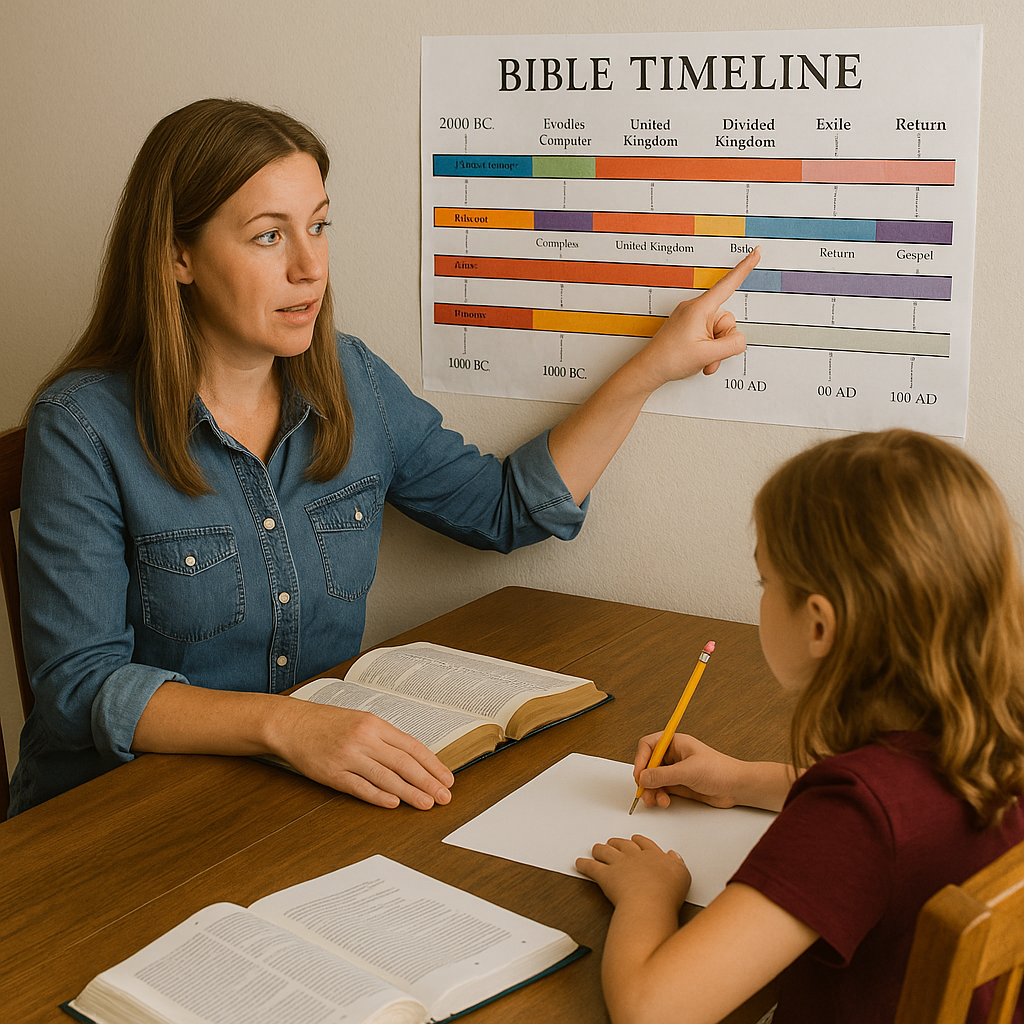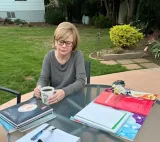30-Minute Bible Timeline Lesson
Teach your kids the Bible’s big story in just 30 minutes—no printouts needed. Follow this simple lesson outline and spark their curiosity today.

Objective: In 30 minutes, students will explore the major events of the Bible—from Creation to the early Church—by constructing a visual timeline and discussing how each era points to God’s unfolding story.

Materials Needed (no printables required)
- A long roll of butcher or craft paper (about 1.5 m)
- Colored markers or crayons
- Sticky notes or index cards (20–25 pieces)
- Tape or poster putty
- A simple Bible or children’s Bible storybook
Preparation (5 minutes)
- Unroll the paper along a table or wall at child height.
- Draw a horizontal line down the center—this is your “Bible timeline.”
- Mark five equally spaced blank sections for the five major eras:
- Creation to the Flood
- Patriarchs to Exodus
- Judges to Kings
- Exile to Return
- Jesus to Early Church
Step 1: Storytelling Warm-Up (5 minutes)
Gather around the timeline. Ask: “If I said ‘Once upon a time…’ what comes to mind?” Invite two volunteers to share brief ideas. Then:
- Creation to the Flood
- Read Genesis 1:1–5 aloud: “In the beginning God created the heavens and the earth. … and there was evening, and there was morning—the first day.”
- Summarize: God made everything good—but people turned away, leading to the Flood.
- Ask: “What does it mean that God ‘saw that it was good’?”
- Patriarchs to Exodus
- Read Genesis 12:1–3: God calls Abraham.
- Summarize: God chose Abraham’s family to bless the world, then delivered them from slavery in Egypt.
- Ask: “Why might a promise matter more than a place?”
Have the children volunteer one word to describe each era (e.g., “Creation,” “Promise,” “Freedom”). Write those words on the timeline’s first two sections.
Step 2: Building the Timeline (10 minutes)
Hand each child 4–5 sticky notes or index cards. Assign events to write and place:
- Creation (Genesis 1–2)
- Noah’s Ark (Genesis 6–9)
- Abraham’s Call (Genesis 12)
- Joseph in Egypt (Genesis 37–50)
- Exodus (Exodus 12–14)
- Joshua Enters the Land (Joshua 1–6)
- Judges (e.g., Gideon, Samson)
- King David (1 Samuel 16–17; 2 Samuel 5)
- Division of the Kingdom (1 Kings 12)
- Exile (2 Kings 24–25)
- Return (Ezra, Nehemiah)
- Prophets (e.g., Isaiah’s vision)
- Jesus’ Birth (Luke 2)
- Jesus’ Ministry (selected miracle)
- Crucifixion & Resurrection (Luke 23–24)
- Great Commission (Matthew 28:18–20)
- Pentecost (Acts 2)
- How to place them:
- Children write the event name and a single sentence summary.
- Peel and stick each note in the correct section on the timeline.
- If uncertain, encourage teamwork—let them look up a verse or ask you.
As the last notes go up, step back and admire the completed line: a visual story from Creation to the birth of the Church.
Step 3: Deep Dive Discussion (10 minutes)
Choose three key events and explore them together. For each:
a. Abraham’s Call (Genesis 12:1–3)
- Read Genesis 12:1–3 aloud.
- Discuss:
- “God told Abraham to leave home with no map—how might that feel?”
- “What promise did God make, and how was it for more than Abraham?”
- Modern application:
- Talk about trusting God when facing big changes (new school, moving, making friends).
b. Exodus—Freedom Story (Exodus 14:13–14)
- Read the moment Moses tells the people, “The Lord will fight for you; you need only to be still.”
- Discuss:
- “Why is trusting better than worrying?”
- “Where in our lives might God want us to ‘be still’?”
- Modern application:
- Relate to a child’s fear—first day, test anxiety, conflict at home—and practicing trust through a short breathing prayer.
c. Pentecost—Spirit Arrives (Acts 2:1–4)
- Read Acts 2:1–4.
- Discuss:
- “Why did believers need a powerful gift to share the story?”
- “How can we rely on the Holy Spirit today?”
- Modern application:
- Encourage children to ask for help in prayer when they feel shy telling others about Jesus.
Step 4: Wrap-Up & Reflection (5 minutes)
Gather everyone back around the timeline. Ask:
- What surprised you most on our timeline today?
- Which story would you tell a friend first?
- How does seeing all these events make you feel about God’s plan?
Invite each child to name one thing they will remember—then close with a brief prayer:
“Thank You, God, for guiding us from the first day of Creation to the birth of Your Church. Help us trust Your promises, follow Your leading, and share Your story everywhere we go. In Jesus’ name, Amen.”
Connecting to Modern Life
- Trust in uncertainty: Just as Abraham stepped into the unknown, we face new challenges—changing schools, new siblings, family moves. God’s promises still hold.
- Freedom from fear: Like crossing the Red Sea, we can step past worry when we remember God’s past faithfulness.
- Empowerment for mission: The same Spirit at Pentecost equips us to speak kindness, truth, and hope into our classrooms and playgrounds.


